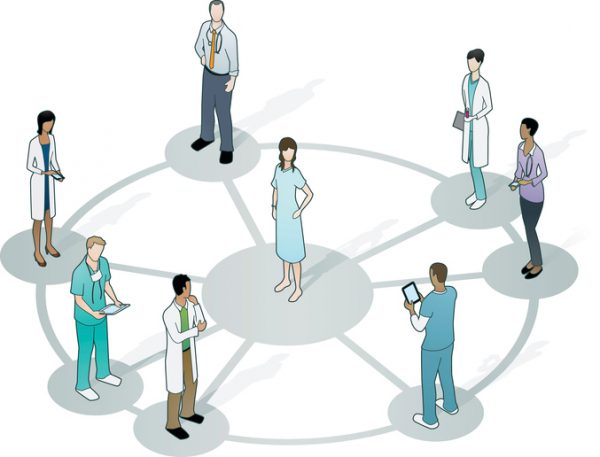
As today’s healthcare landscape continues to change, the standard of optimizing healthcare performance has developed beyond the Triple Aim (enhancing the patient experience, improving population health, and lowering costs) to focus on the Quadruple Aim, which additionally factors in the clinician’s overall well-being. With the promise to re-engineer processes that don’t add value and automate tasks that are increasingly time-consuming and difficult, digital transformations and emerging technologies allow staff to focus their time on patient care and meet the Quadruple Aim. Patients today want personalized experiences that meet their needs and provide better outcomes. Digital transformation is making this possible in support of both the patient and clinician experience.
Among the common focuses in healthcare is the desire to improve health outcomes via patient engagement. Healthcare providers are looking for the best ways to create the most favorable environment for their patients and their continued care. Modern patient engagement platforms can offer a better care experience for patients and provide various opportunities for clinicians to educate, engage, and connect for better outcomes.

With the Rise of AI, What IP Disputes in Healthcare Are Likely to Emerge?
Munck Wilson Mandala Partner Greg Howison shared his perspective on some of the legal ramifications around AI, IP, connected devices and the data they generate, in response to emailed questions.
Top-tier patient engagement systems utilize scalable architecture on open APIs to save time and provide support across the care continuum. This approach facilitates advanced functionality with integrations to the electronic health record (EHR) and other HIT including nurse call, environmental controls, and meal ordering to drive independence for the patient and operational efficiency for clinicians. The most advanced digital systems offer universal access through a host of devices and technology to further connect the entire facility. From infusion centers to emergency departments and outside the walls of the healthcare facility, this innovative technology keeps patients and providers seamlessly connected to move priorities forward and reallocate time to patient care.
Why health facilities need to consider broad integrations
As staffing shortages continue, healthcare facilities need to pursue new solutions that save time. But time can’t truly be saved; it will always march on. What facilities managers can do is consider solutions that will optimize time and reach greater value. Optimizing time can vary by healthcare facility, though. At some facilities, optimizing time means reducing manual tasks with solutions like automatically documenting an educational transaction into the EHR. In other instances, facilities have found the best success with systems that alert the nurse to check in with the patient, follow up on a missed learning verification question, or respond to a survey question indicating a service concern. Healthcare leadership must listen and consider the solutions that best optimize time for their teams.
New technologies thoughtfully implemented help providers reallocate time and deliver new value by aligning efforts with provider goals to enhance the experience for patients. Leveraging these new digital solutions allows clinicians to streamline lower-priority and non-clinical tasks, so they’re able to focus on bedside patient care. Improving care and outcomes are the primary goals of patient engagement systems.
Time can also be optimized outside of the direct bedside for both the patient and staff members. Using a secure digital engagement platform, patients can review their health records, check prescriptions, schedule appointments, ask doctors a question, view lab results, and share health data with their providers. And because most of these tools are built mobile-first, individuals can safely navigate their health journey from the comfort of their own phone, tablet, or even their television. Patients who are actively engaged in their own healthcare journeys see more improvement than passive participants.
At the point of care, integrations with these systems help the patient take on a more active role in their care and manage non-clinical aspects of their admission with ease. For example, engagement platforms allow the patient to change the room’s temperature, lower the lights, order a meal, and place a service request without needing face time with a nurse. It gives the patient a sense of autonomy and independence and allows staff to remain focused on care.
Why patients and clinicians need to connect & collaborate
Patient engagement systems aim to boost patient participation by leveraging the healing potential of collaboration, communication, and empowerment. For example, an Interactive Patient Care System (IPS) with Smart TVs can function as a communication hub connecting patients and providers throughout the recovery process. This is achieved through cost-effective integrations between the IPS and existing HIT applications, which provide an enhanced experience with educational materials and improved collaboration tools. Prescribed digital careflows guide patients through a specific episode to enhance outcomes and reduce readmission or help with the ongoing self-management of a condition. This feature saves staff the time of searching, selecting, and assigning educational content for the patient’s review. Reassigning non-clinical care and administrative tasks allow staff to focus more on patient care.
To provide the ability to further connect and collaborate, digital whiteboards in patient rooms and digital door signs conveniently convey critical information to staff, patients, and families, such as daily schedules, precautions, and the current care team. This automatically updates from integrated hospital systems without manual inputs, streamlining the delivery of care, increasing transparency, and reducing time spent performing unnecessary or repetitive tasks. Advanced systems also offer a provider dashboard that integrates with the EHR and allows the care team to view progress in real time from various devices.
Continue to move care forward
As healthcare continues to advance, well-rounded care for both patients and healthcare staff needs to progress with it. Throughout hospitals and healthcare facilities, teams must deliver excellent care, ensure the latest technology to meet patient expectations, and provide high-quality experiences. Even so, the well-being of clinicians and healthcare staff must also be factored into the equation as a top priority. Patient engagement systems seek to lessen the daily challenges faced by healthcare professionals and support their efforts in ensuring better patient outcomes.














